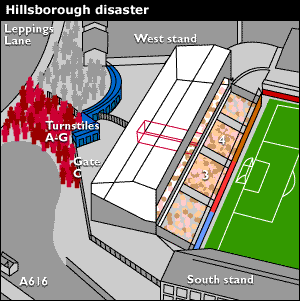 The tragedy that claimed the lives of 96 Liverpool football fans, shattered a community and shook the world of football took a matter of minutes to unfold.
The tragedy that claimed the lives of 96 Liverpool football fans, shattered a community and shook the world of football took a matter of minutes to unfold.In its simplest terms, Hillsborough was a case of overcrowding in the central standing area allocated to Liverpool fans at the FA Cup semi-final match against Nottingham Forest.
Late arrival
In his extensive 1989 report into the disaster, Lord Justice Taylor gave a detailed account of the events leading up to the catastrophic crush.
The disaster began to unfold at approximately 2.30pm.
With half an hour before kick-off, most of the Nottingham Forest supporters were in their seats.
Meanwhile the area reserved for the Liverpool supporters - the Leppings Lane end of the stadium - was half empty.
But outside, it was a different story, with more than 2,000 Liverpool supporters building up against the turnstiles to the Leppings Lane entrance.
Some had arrived late from their journey across the Pennines. Others had stayed outside to make the most of the sunshine.
There were also those who had come without tickets to the all-ticket match, hoping to buy them at the ground.
But whatever the reason for the late rush, anxiety among both fans and police was mounting as the minutes to kick-off ticked by.
Open the gate
By 2.45pm the crowd had swelled to over 5,000, making entry to turnstiles virtually impossible. Those who did get through were short of breath and sweating profusely from the crush.
As the minutes passed, it became increasing clear that, despite police efforts, the mass of people would never get through by 3pm.
There was also a more serious risk of some being dangerously hurt. Something had to be done.
Suddenly at 2.52pm, the large blue, concertina steel door - Gate C - in the perimeter wall was slid open by a police officer.
Those at its entrance tumbled through. Those at the back pushed harder still. The logjam was unstuck. But things quickly got out of control.
Where fans had been entering in ones and twos through the turnstiles, there was now a wave of about 2,000 racing to the see the start of the game.
The majority took the most obvious route: straight ahead through the tunnel of gangway 2.
They piled into the back of pens of 3 and 4, which were already uncomfortably full, crushing those at the front.
Fatal crush
At 2.54pm the teams came onto the pitch. Fans at the back of the pens pushed forward for a better view, unaware that people were dying in the front.
As the excitement of the game grew, there were more surges, each causing a squeeze more perilous than the last.
Finally, with fans spilling through a narrow escape onto the pitch or being lifted to the seating areas above, a policeman realised what was happening.
At 3.06pm, six minutes into the game, he ordered the referee to stop the game.
Only then did the scale of the disaster become clear. Bodies were lifted forward and laid out on the pitch - many teenagers and children.
People screamed for their loved ones as ambulance staff fought to save lives.
Advertising hoardings were torn down as makeshift stretchers in a desperate attempt to bring faster relief.
By 4.50pm, the scheduled end of the game, the ground was empty.
Abandoned clothing and programmes littered the scene of the disaster.
While nearby the bodies of the dead lay in the stadium's gymnasium.
from http://news.bbc.co.uk
No comments:
Post a Comment